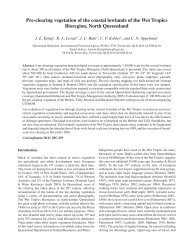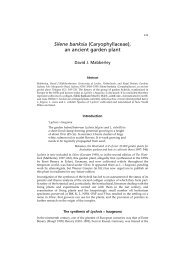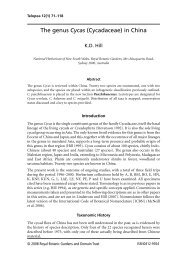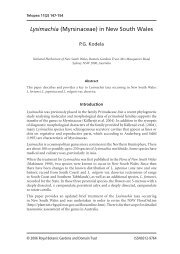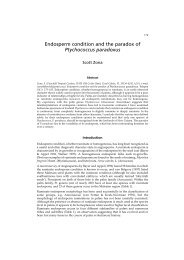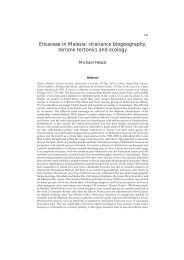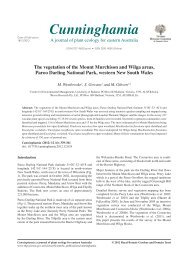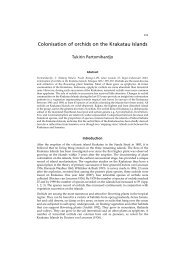Bryophytes and their distribution in the Blue Mountains region of ...
Bryophytes and their distribution in the Blue Mountains region of ...
Bryophytes and their distribution in the Blue Mountains region of ...
You also want an ePaper? Increase the reach of your titles
YUMPU automatically turns print PDFs into web optimized ePapers that Google loves.
244 Cunn<strong>in</strong>ghamia 10(2): 2007 Down<strong>in</strong>g et al, <strong>Bryophytes</strong> <strong>in</strong> <strong>the</strong> <strong>Blue</strong> Mounta<strong>in</strong>s<br />
that time perhaps seen as a sou<strong>the</strong>rn extension <strong>of</strong> <strong>the</strong> <strong>Blue</strong><br />
Mounta<strong>in</strong>s. Most are accepted as alp<strong>in</strong>e species <strong>and</strong> have<br />
been listed by Ramsay et al. (1986) as occurr<strong>in</strong>g <strong>in</strong> <strong>the</strong><br />
alp<strong>in</strong>e areas <strong>of</strong> New South Wales above 1800 m elevation.<br />
The species are: Aulacomnium palustre (Hedw.) Schwägr.,<br />
Bl<strong>in</strong>dia robusta Hampe, Bryum australe Hampe, Catagonium<br />
nitens (Brid.) Cardot, Entosthodon apophysatus (Taylor)<br />
Mitt., Lepyrodon pseudoalgurus B.H.Allen, Notoligotrichum<br />
crispulum (Hook.f. & Wilson) G.M.Sm., Physcomitrium<br />
conicum Mitt., Polytrichastrum alp<strong>in</strong>um (Hedw.) G.L.Sm.<br />
<strong>and</strong> Sanionia unc<strong>in</strong>ata (Hedw.) Loeske. Only two <strong>of</strong> <strong>the</strong>se<br />
species collected by von Mueller, Polytrichastrum alp<strong>in</strong>um<br />
<strong>and</strong> Bl<strong>in</strong>dia robusta, have s<strong>in</strong>ce been recorded from <strong>the</strong> <strong>Blue</strong><br />
Mounta<strong>in</strong>s.<br />
Polytrichastrum alp<strong>in</strong>um has been recorded from Kanangra<br />
Boyd National Park, above 1000 m a.s.l., (by J. Glime <strong>in</strong> 1981)<br />
<strong>and</strong> at Wentworth Falls (by H. Ramsay <strong>in</strong> 1977). This species<br />
has also been recorded from <strong>the</strong> summit <strong>of</strong> Mount Canobolas,<br />
1395 m a.s.l., 130 km north-west <strong>of</strong> Katoomba (Down<strong>in</strong>g,<br />
Oldfield & Fairburn-Wilson 2002), mak<strong>in</strong>g its presence <strong>in</strong> <strong>the</strong><br />
higher areas <strong>of</strong> <strong>the</strong> <strong>Blue</strong> Mounta<strong>in</strong>s not surpris<strong>in</strong>g.<br />
Bl<strong>in</strong>dia robusta is a conspicuous species <strong>and</strong> <strong>the</strong>re are two<br />
specimens (<strong>in</strong> <strong>the</strong> John Ray Herbarium, University <strong>of</strong> Sydney<br />
(SYD)) collected <strong>in</strong> 1930 at Wentworth Falls by A. Burges.<br />
There are a number <strong>of</strong> o<strong>the</strong>r moss specimens collected by<br />
Burges at Wentworth Falls on <strong>the</strong> same date, <strong>and</strong> as <strong>the</strong>se<br />
species still commonly occur <strong>in</strong> <strong>the</strong> vic<strong>in</strong>ity <strong>of</strong> Wentworth<br />
Falls, it is apparent that Burges did collect B. robusta from<br />
this location. It is difficult to imag<strong>in</strong>e how its occurrence<br />
along stream banks would have been overlooked by both<br />
earlier <strong>and</strong> later collectors. We have been unable to f<strong>in</strong>d<br />
it anywhere <strong>in</strong> <strong>the</strong> <strong>Blue</strong> Mounta<strong>in</strong>s <strong>and</strong> it may have been<br />
destroyed by drought, fire or urban development.<br />
Habitat <strong>and</strong> ecological <strong>in</strong>formation on bryophytes is<br />
generally very limited. Many herbarium packets (although<br />
appropriately labelled with location) bear m<strong>in</strong>imal<br />
<strong>in</strong>formation describ<strong>in</strong>g l<strong>and</strong>form (plateau, ridge, valley, <strong>and</strong><br />
canyon), aspect, moisture or lack <strong>of</strong> it, vegetation type (heath,<br />
woodl<strong>and</strong>, forest, <strong>and</strong> closed forest), degree <strong>of</strong> shad<strong>in</strong>g,<br />
substrate (rock, soil or s<strong>and</strong>, tree trunk, tree branches, tree<br />
fern, fallen log), underly<strong>in</strong>g rock (s<strong>and</strong>stone, shale, basalt,<br />
limestone, <strong>and</strong> granodiorite) or associated bryophytes. Such<br />
specimens have contributed to species lists for locations, but<br />
could not contribute <strong>in</strong>formation concern<strong>in</strong>g habitat.<br />
O<strong>the</strong>r problems relate to identification. In <strong>the</strong> case <strong>of</strong> taxa<br />
that have been viewed by experts <strong>in</strong> recent years, it is<br />
possible to be confident <strong>in</strong> <strong>the</strong> names allocated to specimens,<br />
e.g. Macromitrium specimens determ<strong>in</strong>ed by Vitt & Ramsay,<br />
Papillaria determ<strong>in</strong>ed by H. Streimann, Sphagnum by R.<br />
Seppelt <strong>and</strong> Aneura <strong>and</strong> Riccardia determ<strong>in</strong>ed by H. Hewson.<br />
However, <strong>the</strong>re are many groups, such as Campylopus,<br />
Grimmia <strong>and</strong> Leucobryum, for which identification is<br />
challeng<strong>in</strong>g. Often <strong>the</strong>re are no recent publications <strong>and</strong> it is<br />
not with<strong>in</strong> <strong>the</strong> scope <strong>of</strong> this study to check <strong>the</strong> determ<strong>in</strong>ations<br />
<strong>of</strong> all <strong>the</strong> specimens held <strong>in</strong> various herbaria.<br />
Discussion<br />
The effect <strong>of</strong> accessibility on bryophyte record<strong>in</strong>g<br />
There was a considerable difference <strong>in</strong> <strong>the</strong> number <strong>of</strong> species<br />
recorded at different locations (Table 5) <strong>and</strong> accessibility has<br />
probably been <strong>the</strong> major factor determ<strong>in</strong><strong>in</strong>g <strong>the</strong> number <strong>of</strong><br />
species recorded from some locations. Follow<strong>in</strong>g construction<br />
<strong>of</strong> <strong>the</strong> railway <strong>in</strong> 1868, visitors were able to travel by tra<strong>in</strong><br />
to Lawson, Wentworth Falls <strong>and</strong> Blackheath (Valder 1988).<br />
Govetts Leap (at Blackheath) <strong>and</strong> Wentworth Falls were <strong>the</strong><br />
most popular <strong>Blue</strong> Mounta<strong>in</strong>s dest<strong>in</strong>ations, accord<strong>in</strong>g to The<br />
Railway Guide <strong>of</strong> <strong>the</strong> day. Cheap tra<strong>in</strong> fares <strong>and</strong> a growth<br />
<strong>in</strong> tourist facilities attracted many visitors. Construction <strong>of</strong><br />
walk<strong>in</strong>g tracks at Wentworth Falls <strong>and</strong> Govetts Leap began<br />
<strong>in</strong> 1890. By 1910, motor coaches facilitated travel from <strong>the</strong><br />
railway to more distant locations (Burke 1988). In 1875,<br />
when <strong>the</strong> Mount Wilson Railway Station (later changed<br />
to Bell) was completed, it became much easier to travel to<br />
Mount Wilson <strong>and</strong> Mount Irv<strong>in</strong>e (Valder 1988).<br />
The early collectors, Whitelegge, Forsyth <strong>and</strong> Watts, all used<br />
rail <strong>and</strong> <strong><strong>the</strong>ir</strong> collections, for example from Gr<strong>and</strong> Canyon at<br />
Blackheath, from Valley <strong>of</strong> <strong>the</strong> Waters at Wentworth Falls,<br />
from Dantes Glen at Lawson, all <strong>in</strong>dicate <strong>the</strong>y used <strong>the</strong> same<br />
walk<strong>in</strong>g paths that we use today. The Rev. W.W. Watts walked<br />
or travelled on horseback to visit parishioners (Ramsay 1980)<br />
but today we still use <strong>the</strong> same road that Watts used, w<strong>in</strong>d<strong>in</strong>g<br />
through closed forest from Mount Wilson to Mount Irv<strong>in</strong>e.<br />
Factors affect<strong>in</strong>g <strong>distribution</strong> <strong>of</strong> bryophytes <strong>in</strong> <strong>the</strong> <strong>Blue</strong><br />
Mounta<strong>in</strong>s: topography <strong>and</strong> geology<br />
Most <strong>of</strong> <strong>the</strong> bryophytes <strong>in</strong> <strong>the</strong> <strong>Blue</strong> Mounta<strong>in</strong>s are found <strong>in</strong> <strong>the</strong><br />
closed forests <strong>of</strong> gullies <strong>and</strong> valleys on s<strong>and</strong>stone <strong>and</strong> shale.<br />
The dense canopies <strong>of</strong> closed forests protect bryophytes<br />
from high light, extreme temperatures <strong>and</strong> desiccation by<br />
strong w<strong>in</strong>ds. Damp rocks, soil, fallen logs <strong>and</strong> tree roots<br />
are <strong>of</strong>ten covered with bryophytes. Unlike many eucalypts,<br />
trees <strong>of</strong> <strong>the</strong> closed forest, such as Doryphora sassafras,<br />
Ceratopetalum apetalum <strong>and</strong> Callicoma serratifolia have<br />
persistent bark, allow<strong>in</strong>g epiphytic bryophytes to colonise<br />
tree trunks, branches <strong>and</strong> twigs. <strong>Bryophytes</strong> that can survive<br />
<strong>in</strong> low light levels <strong>of</strong> closed forest are <strong>of</strong>ten large <strong>and</strong><br />
conspicuous, with growth forms that allow <strong>the</strong>m to access<br />
maximum light levels. For example, pendulous mosses<br />
(Papillaria spp.) hang from tree trunks <strong>and</strong> tree fern trunks,<br />
<strong>and</strong> dendroid mosses <strong>and</strong> liverworts (Hypnodendron vitiense<br />
subsp. australe, Hypopterygium spp. <strong>and</strong> Hymenophyton<br />
flabellatum) grow upwards from wet rocks <strong>and</strong> soil along<br />
creek banks (Figures 4, 5). Tall, upright species, such as<br />
Dawsonia superba (Figure 12) rapidly colonise newly<br />
exposed earth <strong>of</strong> l<strong>and</strong> slips, or gap<strong>in</strong>g holes <strong>in</strong> <strong>the</strong> ground<br />
where mature trees have fallen. Three beautiful mosses,<br />
Neckera pennata, Cyathophorum bulbosum <strong>and</strong> Calomnion<br />
complanatum grow on <strong>the</strong> trunks <strong>of</strong> tree ferns, tree trunks<br />
<strong>and</strong> wet rocks, almost always <strong>in</strong> deep shade close to streams.





